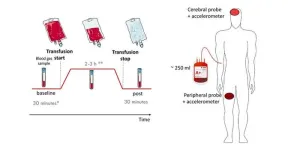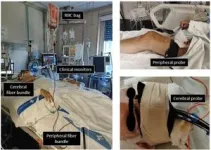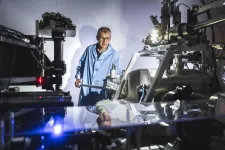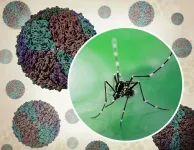(Press-News.org) Red blood cell transfusions (RBCTs) are life-saving treatments for critically ill patients suffering from anemia, a condition where the body lacks enough healthy red blood cells to deliver oxygen effectively. While effective in increasing oxygen levels in the blood, transfusions can disrupt blood flow and oxygen distribution, potentially causing harm to vital organs like the brain. To address this, researchers are exploring new tools to monitor these effects more precisely.
A recent study reported in Biophotonics Discovery investigated a novel technology called hybrid diffuse optics (DO), which uses near-infrared light to continuously measure changes in blood flow and oxygen levels noninvasively. The goal was to understand whether this technique could enhance decision-making and improve outcomes by providing detailed insights into how oxygen is delivered and utilized in the body. Unlike traditional methods that provide only systemic data (e.g., blood samples), this technology offers a detailed look at local changes in specific tissues.
The study monitored critically ill patients undergoing RBCTs in an intensive care unit. Optical probes placed on the patients’ foreheads (to measure brain responses) and muscles (to measure peripheral responses) provided continuous data before, during, and after transfusions.
After transfusion, oxygen supply increased significantly in both the brain and muscles. This was confirmed by higher levels of oxygenated hemoglobin and total hemoglobin. Oxygen extraction fractions decreased in both the brain and peripheral muscles, indicating that tissues were better oxygenated. While the brain maintained stable blood flow, the muscles experienced a significant increase in blood flow after transfusion. This suggests that the brain had protective mechanisms at play to regulate oxygen supply. The study found no signs of harmful effects like over-perfusion (excess blood flow) or under-perfusion in the brain, highlighting the potential safety of RBCTs when guided by these advanced monitoring techniques.
This research demonstrates the potential of hybrid DO as a tool for optimizing blood transfusions, helping doctors tailor treatments to individual patients, minimizing risks and improving outcomes. For instance, doctors could use this tool to confirm that the brain is receiving enough oxygen without risking excessive blood flow to other areas, which might cause swelling or other complications. This study is a promising step toward integrating advanced optical tools into routine medical care, paving the way for safer and more effective treatments for critically ill patients.
The insights gained from this study could lead to:
Personalized medicine. Real-time monitoring could guide more precise transfusion strategies, ensuring each patient gets exactly what they need.
Improved decision-making. By identifying which tissues are under stress, clinicians can make more informed decisions about when to intervene.
Wider adoption of noninvasive tools. The use of optical technologies could reduce reliance on invasive procedures, making critical care safer and more comfortable for patients.
Beyond critical care, this technology could have applications in surgery, neonatal care, neurocritical care, and managing chronic conditions.
For details, see the original Gold Open Access article by S. Tagliabue et al., “Hybrid diffuse optical appraisal of peripheral and cerebral changes in critically ill patients receiving red blood cell transfusion,” Biophotonics Discovery 2(1), 015001 (2025), doi: 10.1117/1.BIOS.2.1.015001
END
Improving blood transfusion monitoring in critical care patients: Insights from diffuse optics
Hybrid diffuse optics uses near-infrared light to noninvasively and continuously monitor blood flow and oxygen levels, which can optimize red blood cell transfusions
2025-01-31
ELSE PRESS RELEASES FROM THIS DATE:
Powerful legal and financial services enable kleptocracy, research shows
2025-01-31
Powerful legal and financial service industries are enabling kleptocracy and corrupt elites to operate with relative impunity, a new study shows.
The research details how “enablers” from these industries exploit deregulation and the under-enforcement of the law to game the system. They can offshore their clients' wealth, and enhance their reputations and influence via philanthropy, political donations, and the use of the UK's punitive libel regime.
Most of this “enabling” is likely ...
Carbon capture from constructed wetlands declines as they age
2025-01-31
COLUMBUS, Ohio – Constructed wetlands do a good job in their early years of capturing carbon in the environment that contributes to climate change – but that ability does diminish with time as the wetlands mature, a new study suggests.
Researchers examined soil core samples taken from two constructed freshwater wetlands and compared them to data from previous studies of the same wetlands over 29 years to determine how well human-made wetlands sequester — or capture and store — ...
UCLA-led study establishes link between early side effects from prostate cancer radiation and long-term side effects
2025-01-31
Men undergoing radiation therapy for prostate cancer who experience side effects early in treatment may face a higher risk of developing more serious long-term urinary and bowel health issues, according to a new study led by investigators from the UCLA Health Jonsson Comprehensive Cancer Center.
The study found that patients who experienced moderate acute urinary side effects in the first three months after radiation were nearly twice as likely to develop late urinary complications years later compared to those without early symptoms. Similarly, patients with early bowel side effects had nearly double the risk of chronic bowel issues.
The findings, ...
Life cycles of some insects adapt well to a changing climate. Others, not so much.
2025-01-31
As insect populations decrease worldwide in what some have called an "insect apocalypse," biologists are desperate to determine how the six-legged creatures are responding to a warming world and to predict the long-term winners and losers.
A new study of Colorado grasshoppers shows that, while the answers are complicated, biologists have much of the knowledge they need to make these predictions and prepare for the consequences.
The findings, published Jan. 30 in the journal PLOS Biology, come thanks to the serendipitous ...
With generative AI, MIT chemists quickly calculate 3D genomic structures
2025-01-31
CAMBRIDGE, MA -- Every cell in your body contains the same genetic sequence, yet each cell expresses only a subset of those genes. These cell-specific gene expression patterns, which ensure that a brain cell is different from a skin cell, are partly determined by the three-dimensional structure of the genetic material, which controls the accessibility of each gene.
MIT chemists have now come up with a new way to determine those 3D genome structures, using generative artificial intelligence. Their technique can predict thousands of structures in just minutes, making it much speedier than existing experimental methods for analyzing the structures.
Using this technique, researchers could more ...
The gut-brain connection in Alzheimer’s unveiled with X-rays
2025-01-31
Scientists led by the Institute of Nanotechnology in Italy, in collaboration with the ESRF, the European Synchrotron in Grenoble, France, have discovered how X-ray micro- and nano- tomography can provide clues on the processes that link the gut neurons with those in the brain and may trigger Alzheimer’s. The results are published in Science Advances.
Alzheimer’s disease, the most common type of dementia, is a neurodegenerative disorder characterized by brain alteration including synaptic loss, chronic inflammation and neuronal cell death.
In recent years, scientists have found evidence that the gut and the brain communicate through the neurons placed in ...
NIH-funded clinical trial will evaluate new dengue therapeutic
2025-01-31
A clinical trial supported by the National Institutes of Health (NIH) is testing an experimental treatment designed to help people suffering the effects of dengue, a mosquito-borne viral disease. The study is supported by NIH’s National Institute of Allergy and Infectious Diseases (NIAID), and will involve exposing adult volunteers to a weakened strain of dengue virus that causes a mild form of the disease and administering an investigational therapeutic at various doses to assess its safety and ability to lessen symptoms.
Dengue ...
Sound is a primary issue in the lives of skateboarders, study shows
2025-01-31
Sound plays a significant and often poignant part of skateboarders’ relationship with their sport, a new study shows.
Skateboarders develop the skill to tune into the noise of urban surfaces. They both hear and feel noise and this means images and videos alone are a poor insight into the sport. They use sound to verify the success of their manoeuvres, judge the veracity and capacity of surfaces for use and as a social cue. For some the sensory overload of skateboarding is therapeutic and it helps them connect with others skating nearby.
But ...
Watch what you eat: NFL game advertisements promote foods high in fat, sodium
2025-01-31
ST. LOUIS – Research from Saint Louis University (SLU) and the University of Nevada, Reno School of Medicine finds that some of the most-watched ads promote the worst food options for adults with chronic health conditions.
The findings published online on Jan. 30 in JAMA Network analyzed advertisements transmitted during televised NFL games in the U.S. to assess the nutritional content by serving.
The study found that store-bought foods and quick-service restaurants advertised during NFL games, the most watched sporting events in the U.S., ...
Red Dress Collection Concert hosted by Sharon Stone kicks off American Heart Month
2025-01-31
DALLAS, Jan. 31, 2025 — Academy Award-nominated actress and host Sharon Stone, alongside musical guests Sara Bareilles and Suki Waterhouse, headlined a roster of powerful players in music, entertainment, fashion and philanthropy to officially mark the start of American Heart Month at the Red Dress Collection® Concert on Thursday, January 30. The fashion-forward, musical celebration in New York City serves as the national marquee event for the American Heart Association’s Go Red for Women® movement, celebrating progress made while calling for a renewed commitment to the fight against cardiovascular disease, the number one killer ...
LAST 30 PRESS RELEASES:
Statins significantly reduce mortality risk for adults with diabetes, regardless of cardiovascular risk
Brain immune cells may drive more damage in females than males with Alzheimer’s
Evidence-based recommendations empower clinicians to manage epilepsy in pregnancy
Fungus turns bark beetles’ defenses against them
There are new antivirals being tested for herpesviruses. Scientists now know how they work
CDI scientist, colleagues author review of global burden of fungus Candida auris
How does stroke influence speech comprehension?
B cells transiently unlock their plasticity, risking lymphoma development
Advanced AI dodel predicts spoken language outcomes in deaf children after cochlear implants
Multimodal imaging-based cerebral blood flow prediction model development in simulated microgravity
Accelerated streaming subgraph matching framework is faster, more robust, and scalable
Gestational diabetes rose every year in the US since 2016
OHSU researchers find breast cancer drug boosts leukemia treatment
Fear and medical misinformation regarding risk of progression or recurrence among patients with breast cancer
Glucagonlike peptide-1 receptor agonists and asthma risk in adolescents with obesity
Reviving dormant immunity: Millimeter waves reprogram the immunosuppressive microenvironment to potentiate immunotherapy without obvious side effects
Safety decision-making for autonomous vehicles integrating passenger physiological states by fNIRS
Fires could emit more air pollution than previously estimated
A new way to map how cells choose their fate
Numbers in our sights affect how we perceive space
SIMJ announces global collaborative book project in commemoration of its 75th anniversary
Air pollution exposure and birth weight
Obstructive sleep apnea risk and mental health conditions among older adults
How talking slows eye movements behind the wheel
The Ceramic Society of Japan’s Oxoate Ceramics Research Association launches new international book project
Heart-brain connection: international study reveals the role of the vagus nerve in keeping the heart young
Researchers identify Rb1 as a predictive biomarker for a new therapeutic strategy in some breast cancers
Survey reveals ethical gaps slowing AI adoption in pediatric surgery
Stimulant ADHD medications work differently than thought
AI overestimates how smart people are, according to HSE economists
[Press-News.org] Improving blood transfusion monitoring in critical care patients: Insights from diffuse opticsHybrid diffuse optics uses near-infrared light to noninvasively and continuously monitor blood flow and oxygen levels, which can optimize red blood cell transfusions




